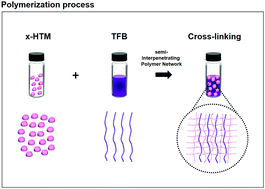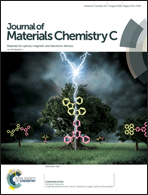A cross-linkable hole transport material having improved mobility through a semi-interpenetrating polymer network approach for solution-processed green PHOLEDs
Abstract
A novel cross-linkable hole transport material (HTM) was used to form a robust layer structure upon continuous wet processes such as spin coating or ink-jet printing. The significantly reduced hole mobility of the cross-linked HTM (x-HTM) was dramatically improved by a semi-interpenetrating polymer network (semi-IPN) approach for ideal charge balance. In other words, we obtained a synergistic effect from the blending of a linear hole transport polymer [TFB, poly(9,9-dioctylfluorene-co-N-(4-butylphenyl)diphenylamine)] with a new x-HTM that realizes pretty low solubility in common organic solvents as well as significantly enhanced hole transport characteristics. As a result, it gave highly efficient solution-processed green phosphorescent organic light-emitting diodes (PHOLEDs) showing a pretty high current efficiency and external quantum efficiency of approximately 51.6 cd A−1 and 14.6% at the blending ratio of 20% (TFB). Particularly, the device lifetime was remarkably improved by a factor of 6.5 compared to the reference device which used an intrinsic x-HTM. To understand the reason for such outstanding improvement, we performed impedance spectroscopy (IS).



 Please wait while we load your content...
Please wait while we load your content...